A Comparative Study of Thermal Performance of Different Nanofluids: An Analytic Approach
Abstract
1. Introduction
2. Problem Formulation
3. Method and Solution
4. Results and Discussion
5. Stretching Sheet Case
6. Shrinking Sheet Case
- The sign for ;
- The symbol for the inclusive term within the square root sign in .
7. Physical Quantities
8. Conclusions
- gives the maximum value for and minimum value for nanofluids in the shrinking sheet case and have the opposite behavior in the stretching sheet case.
- The Nusselt number gives the maximum value for and minimum value for nanoparticles for the shrinking sheet case and have the opposite behavior in the stretching sheet case. However, as silver is expensive, we suggest using .
- For , is more efficient in comparison to the magnetic field effect.
- By decreasing thermal energy and increasing the molecular weight of nanoparticles, the ratio of to the nanoparticle volume fraction is enhanced.
- The Nusselt number reduces the four different kinds of nanoparticles with a vast range of volume fractions.
- has a prominent and efficient effect on heat transfer.
Author Contributions
Funding
Data Availability Statement
Conflicts of Interest
Nomenclature
| Velocity components | Density of nanofluid | ||
| Dynamic viscosity of nanofluid | Electrical conductivity | ||
| Magnetic field | Heat capacitance of nanofluid | ||
| Thermal conductivity of nanofluid | Nanoparticle volume fraction parameter | ||
| Free stream function | Magnetic parameter | ||
| Prandtl number | Mass suction/injection parameter | ||
| Stretching/shrinking parameter | Generalized Laguerre polynomial | ||
| Surface shear stress | Skin friction coefficient | ||
| Local Reynolds number | The dimensionless skin friction coefficient | ||
| Surface heat flux | Local Nusselt number | ||
| Dimensionless Nusselt number | the subscripts , and “nf” | represent the solid-, fluid- and nanofluid-state properties, respectively. |
References
- Zhu, A.; Ali, H.; Ishaq, M.; Junaid, M.S.; Raza, J.; Amjad, M. Numerical Study of Heat and Mass Transfer for Williamson Nanofluid over Stretching/Shrinking Sheet along with Brownian and Thermophoresis Effects. Energies 2022, 15, 5926. [Google Scholar] [CrossRef]
- Choi, S.; Eastman, J.A. Enhancing thermal conductivity of fluids with nanoparticles. In Bejan A. Constructal Thermodynamics, Constructal Law & Second Law Conference, Proceedings of the ASME International Mechanical Engineering Congress and Exposition, San Francisco, CA, USA, 12–17 November 1995; Argonne National Lab.: Argonne, IL, USA, 1995; pp. S1–S8. [Google Scholar]
- Choi, S.; Zhang, Z.G.; Yu, W.; Lockwood, F.E.; Grulke, E.A. Anomalously thermal conductivity enhancement in nanotube suspensions. Appl. Phys. Lett. 2001, 79, 2252–2254. [Google Scholar] [CrossRef]
- Xuan, Y.; Li, Q. Heat transfer enhancement of nanofluids. Int. J. Heat Fluid Flow 2000, 21, 58–64. [Google Scholar] [CrossRef]
- Eastman, J.A.; Choi, S.; Li, S.; Thompson, L.J.; Lee, S. Enhanced Thermal Conductivity through the Development of Nanofluids, Symposium V-Nanophase and Nanocomposite Materials II; Materials Research Society: Pittsburgh, PA, USA, 1996. [Google Scholar]
- Eastman, J.A.; Choi, S.; Li, S.; Yu, W.; Thompson, L.J. Anomalously increased effective thermal conductivities of ethylene glycol-based nanofluids containing copper nanoparticles. Appl. Phys. Lett. 2001, 78, 718–720. [Google Scholar] [CrossRef]
- Karimipour, A.; Nezhad, A.H.; D’Orazio, A.; Esfe, M.H.; Safaei, M.R.; Shirani, E. Simulation of copper–water nanofluid in a micro channel in slip flow regime using the lattice Boltzmann method. Eur. J. Mech. B Fluids 2015, 49, 89–99. [Google Scholar] [CrossRef]
- Hayat, T.; Kiran, A.; Imtiaz, M.; Alsaedi, A. Hydromagnetic mixed convection flow of copper and silver water nanofluids due to a curved stretching sheet. Results Phys. 2016, 6, 904–910. [Google Scholar] [CrossRef][Green Version]
- Hayat, T.; Qayyum, S.; Imtiaz, M.; Alsaedi, A. Comparative study of silver and copper water nanofluids with mixed convection and nonlinear thermal radiation. Int. J. Heat Mass Transf. 2016, 102, 723–732. [Google Scholar] [CrossRef]
- Hayat, T.; Imtiaz, M.; Alsaedi, A.; Alzahrani, F. Effects of homogeneous–heterogeneous reactions in flow of magnetite-Fe3O4 nanoparticles by a rotating disk. J. Mol. Liq. 2016, 216, 845–855. [Google Scholar] [CrossRef]
- Hayat, T.; Qayyum, S.; Imtiaz, M.; Alzahrani, F.; Alsaedi, A. Partial slip effect in flow of magnetite-Fe3O4 nanoparticles between rotating stretchable disks. J. Magn. Magn. Mater. 2016, 413, 39–48. [Google Scholar] [CrossRef]
- Kumar, T.S.; Kumar, B.R. A comparative study of thermal radiation effects on MHD flow of nanofluids and heat transfer over a stretching sheet. Front. Heat Mass Transf. 2017, 9, 13. [Google Scholar] [CrossRef]
- Hayat, T.; Nazar, H.; Imtiaz, M.; Alsaedi, A. Darcy-Forchheimer flows of copper and silver-water nanofluids between two rotating stretchable disks. Appl. Math. Mech. 2017, 38, 1663–1678. [Google Scholar] [CrossRef]
- Sheikholeslami, M.; Ganji, D.D. Free convection of Fe3O4-water nanofluid under the influence of an external magnetic source. J. Mol. Liq. 2017, 229, 530–540. [Google Scholar] [CrossRef]
- Hatami, M.; Jing, D. Optimization of wavy direct absorber solar collector (WDASC) using Al2O3-water nanofluid and RSM analysis. Appl. Therm. Eng. 2017, 121, 1040–1050. [Google Scholar] [CrossRef]
- Biglarian, M.; Gorji, M.; Pourmehran, O.; Ganji, D.D. H2O based different nanofluids with unsteady condition and an external magnetic field on permeable channel heat transfer. Int. J. Hydrogen Energy 2017, 42, 22005–22014. [Google Scholar] [CrossRef]
- Sharma, B.; Kumar, S.; Paswan, M. Analytical solution for mixed convection and MHD flow of electrically conducting non-Newtonian nanofluid with different nanoparticles: A comparative study. Int. J. Heat Technol. 2018, 36, 987–996. [Google Scholar] [CrossRef]
- Fadhilah, D.N.; Bachok, N.; Yacob, N.; Arifin, N.M.; Rosali, H. Unsteady stagnation-point flow and heat transfer over a permeable exponential stretching/shrinking sheet in nanofluid with slip velocity effect: A stability analysis. Appl. Sci. 2018, 8, 2172. [Google Scholar]
- Sheikholeslami, M.; Shehzad, S.A. Numerical analysis of Fe3O4−H2O nanofluid flow in permeable media under the effect of external magnetic source. Int. J. Heat Mass Transf. 2018, 118, 182–192. [Google Scholar] [CrossRef]
- Khan, T.A.; Ahmad, H. CFD-Based Comparative Performance Analysis of Different Nanofluids Used in Automobile Radiators. Arab. 2019, 44, 5787–5799. [Google Scholar] [CrossRef]
- Asker, M.; Gadanya, T.S. Performance Assessment of Flat Plate Solar Collector Using Different Nanofluids. Hittite J. Sci. Eng. 2019, 6, 193–200. [Google Scholar]
- Imtiaz, M.; Shahid, F.; Hayat, T.; Alsaedi, A. Melting heat transfer in Cu-water and Ag-water nanofluids flow with homogeneous-heterogeneous reactions. Appl. Math. Mech. 2019, 40, 465–480. [Google Scholar] [CrossRef]
- Sandhu, H.; Gangacharyulu, D.; Singh, M.K. Experimental study on stability of different nanofluids by using different nanoparticles and basefluids. In Proceedings of the 4th Thermal and Fluids Engineering Conference (TFEC), TFEC-2019-27991, Las Vegas, NV, USA, 14–17 April 2019. [Google Scholar]
- Sravanthi, C.S. Effect of nonlinear thermal radiation on silver and copper water nanofluid flow due to a rotating disk with variable thickness in the presence of nonuniform heat source/sink using the homotopy analysis method. Heat Transf.-Asian Res. 2019, 48, 4033–4048. [Google Scholar] [CrossRef]
- Sajid, T.; Jamshed, W.; Safdar, R.; Hussain, S.M.; Shahzad, F.; Bilal, M.; Rehman, Z.; Rahman, M.M.; Pasha, A.A. Features and aspects of radioactive flow and slippage velocity on rotating two-phase Prandtl nanofluid with zero mass fluxing and convective constraints. Int. Commun. Heat Mass Transf. 2022, 136, 106180. [Google Scholar] [CrossRef]
- Toghraie, D.; Mashayekhi, R.; Arasteh, H.; Sheykhi, S.; Niknejadi, M.; Chamkha, A.J. Two-phase investigation of water-Al2O3 nanofluid in a micro concentric annulus under non-uniform heat flux boundary condition. Int. J. Numer. Methods Heat Fluid Flow 2020, 30, 1795–1814. [Google Scholar] [CrossRef]
- Mostafazadeh, A.; Toghraie, D.; Mashayekhi, R.; Akbari, O.A. Effect of radiation on laminar natural convection of nanofluid in a vertical channel with single- and two-phase approaches. J. Therm. Anal. Calorim. 2019, 138, 779–794. [Google Scholar] [CrossRef]
- Bazdar, H.; Toghraie, D.; Pourfattah, F.; Akbari, O.A.; Nguyen, H.M.; Asadi, A. Numerical investigation of turbulent flow and heat transfer of nanofluid inside a wavy microchannel with different wavelengths. J. Therm. Anal. Calorim. 2020, 139, 2365–2380. [Google Scholar] [CrossRef]
- Mashayekhi, R.; Khodabandeh, E.; Akbari, O.A.; Toghraie, D.; Bahiraei, M.; Gholami, M. CFD analysis of thermal and hydrodynamic characteristics of hybrid nanofluid in a new designed sinusoidal double-layered microchannel heat sink. J. Therm. Anal. Calorim. 2018, 134, 2305–2315. [Google Scholar] [CrossRef]
- Arasteh, H.; Mashayekhi, R.; Goodarzi, M.; Motaharpour, S.H.; Dahari, M.; Toghraie, D. Heat and fluid flow analysis of metal foam embedded in a double-layered sinusoidal heat sink under local thermal non-equilibrium condition using nanofluid. J. Therm. Anal. Calorim. 2019, 138, 1461–1476. [Google Scholar] [CrossRef]
- Freidoonimehr, N.; Rahimi, A.B. Exact-solution of entropy generation for MHD nanofluid flow induced by a stretching/shrinking sheet with transpiration: Dual solution. Adv. Powder Technol. 2017, 28, 671–685. [Google Scholar] [CrossRef]
- Brinkman, H.C. The viscosity of concentrated suspensions and solutions. J. Chem. Phys. 1952, 20, 571. [Google Scholar] [CrossRef]
- Oztop, H.; Abu-Nada, E. Numerical study of natural convection in partially heated rectangular enclosures filled with nanofluids. Int. J. Heat Fluid Flow 2008, 29, 1326–1336. [Google Scholar] [CrossRef]
- Available online: http://www.mhtl.uwaterloo.ca (accessed on 12 March 2019).
- Waini, I.; Ishak, A.; Pop, I. MHD flow and heat transfer of a hybrid nanofluid past a permeable stretching/shrinking wedge. Appl. Math. Mech. 2020, 41, 507–520. [Google Scholar] [CrossRef]
- Mondal, H.; Bharti, S. Spectral Quasi-linearization for MHD Nanofluid Stagnation Boundary Layer Flow due to a Stretching/Shrinking Surface. J. Appl. Comput. Mech. 2020, 6, 1058–1068. [Google Scholar]
- Khan, S.A.; Nie, Y.; Ali, B. Multiple Slip Effects on Magnetohydrodynamic Axisymmetric Buoyant Nanofluid Flow above a Stretching Sheet with Radiation and Chemical Reaction. Symmetry 2019, 11, 1171. [Google Scholar] [CrossRef]
- Lund, L.A.; Omar, Z.; Khan, I.; Sherif, E.M. Dual Solutions and Stability Analysis of a Hybrid Nanofluid over a Stretching/Shrinking Sheet Executing MHD Flow. Symmetry 2020, 12, 276. [Google Scholar] [CrossRef]
- Freidoonimehr, N.; Rostami, B.; Rashidi, M.M.; Momoniat, E. Analytical modelling of three-dimensional squeezing nanofluid flow in a rotating channel on a lower stretching porous wall. Math. Probl. Eng. 2014, 2014, 692728. [Google Scholar] [CrossRef]
- Hartman, P. Ordinary Differential Equations, 2nd ed.; Birkhauser: Basel, Switzerland, 1982. [Google Scholar]
- Turkyilmazoglu, M. Multiple solutions of heat and mass transfer of MHD slip flow for the viscoelastic fluid over a stretching sheet. Int. J. Therm. Sci. 2011, 50, 2264–2276. [Google Scholar] [CrossRef]
- Turkyilmazoglu, M. Exact solutions for two-dimensional laminar flow over a continuously stretching or shrinking sheet in an electrically conducting quiescent couple stress fluid. Int. J. Heat Mass Transf. 2014, 72, 1–8. [Google Scholar] [CrossRef]
- Turkyilmazoglu, M. Heat and mass transfer of MHD second order slip flow. Comput. Fluids 2013, 71, 426–434. [Google Scholar] [CrossRef]
- Abolbashari, M.H.; Freidoonimehr, N.; Nazari, F.; Rashidi, M.M. Entropy analysis for an unsteady MHD flow past a stretching permeable surface in nanofluid. Powder Technol. 2014, 267, 256–267. [Google Scholar] [CrossRef]
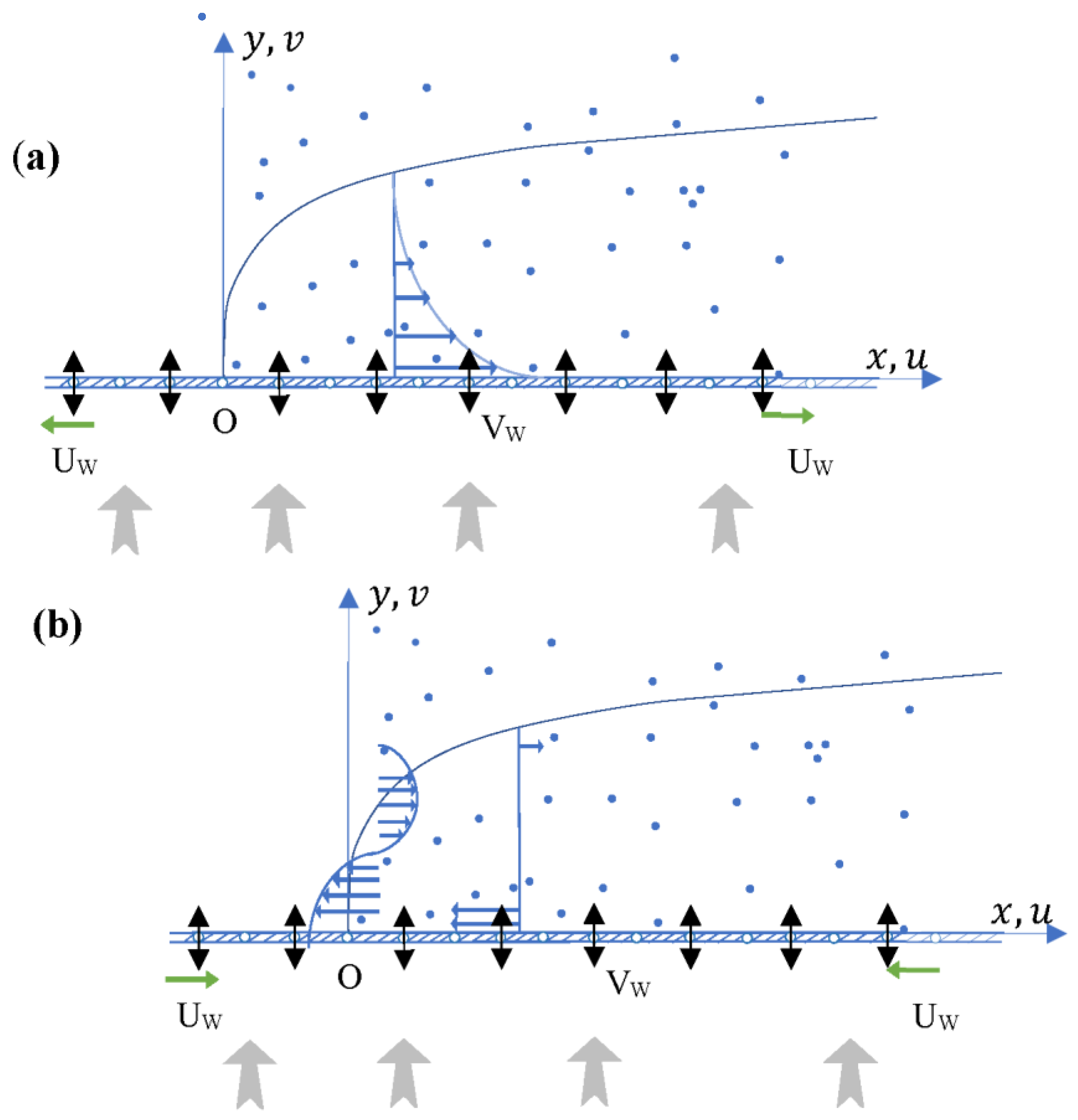
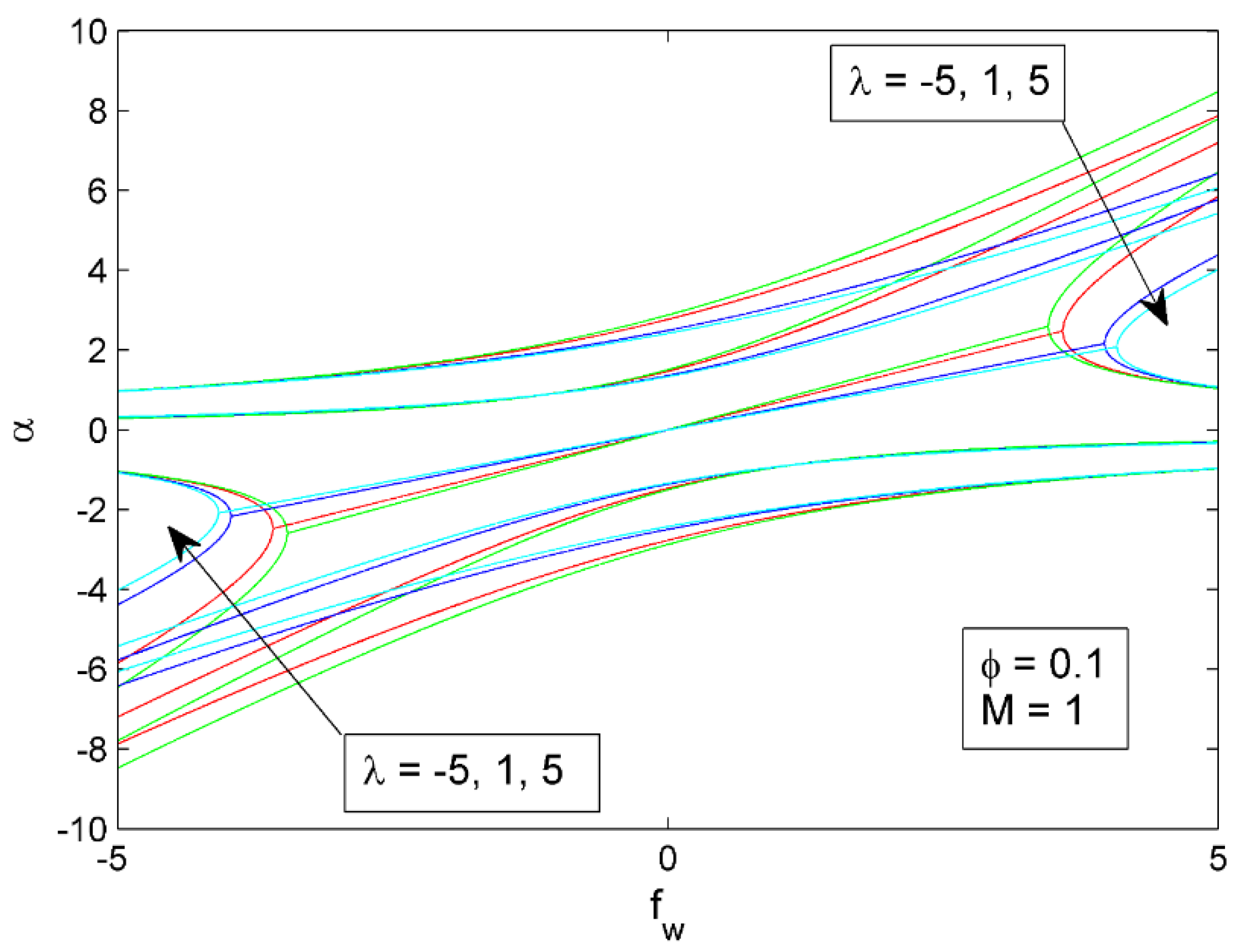
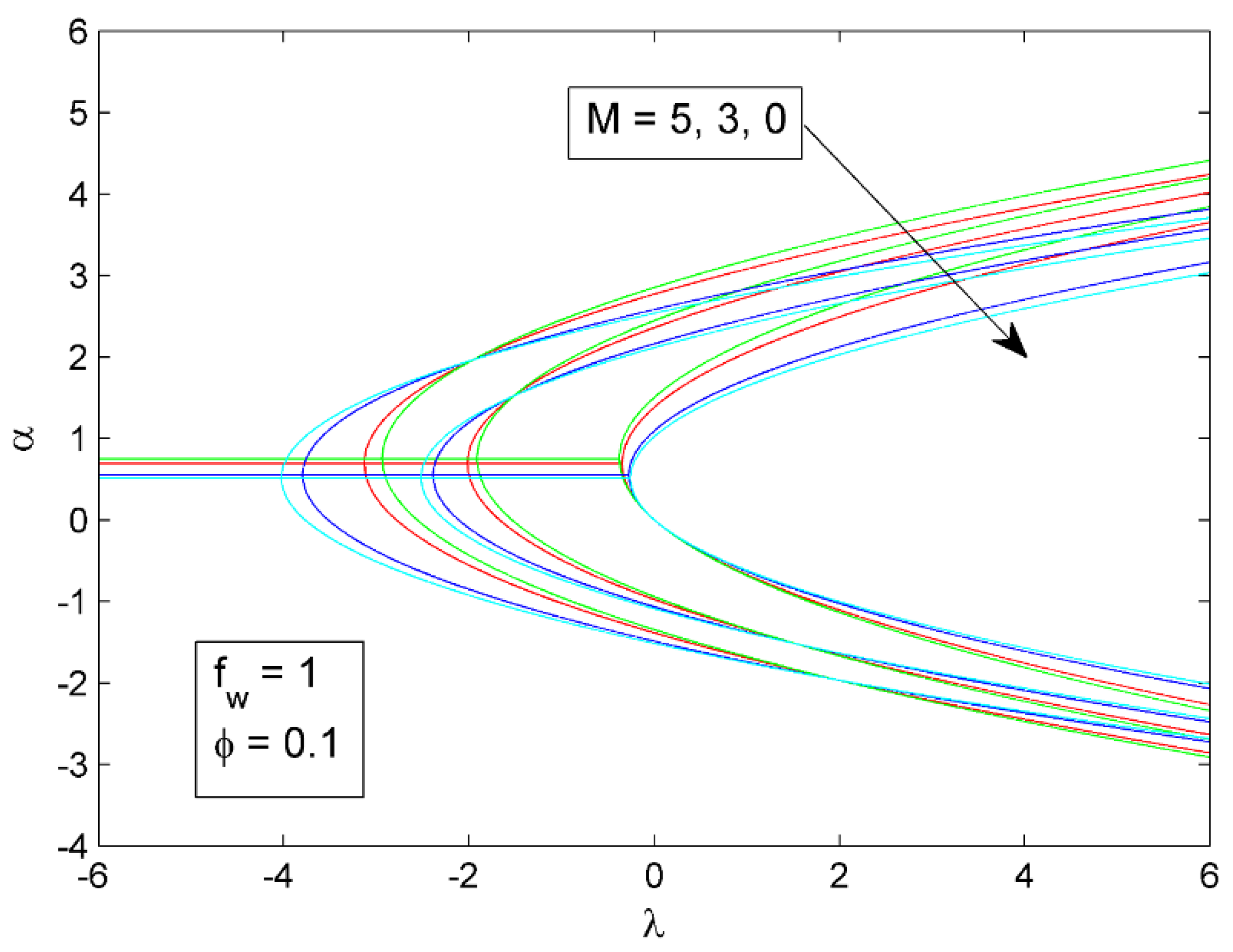
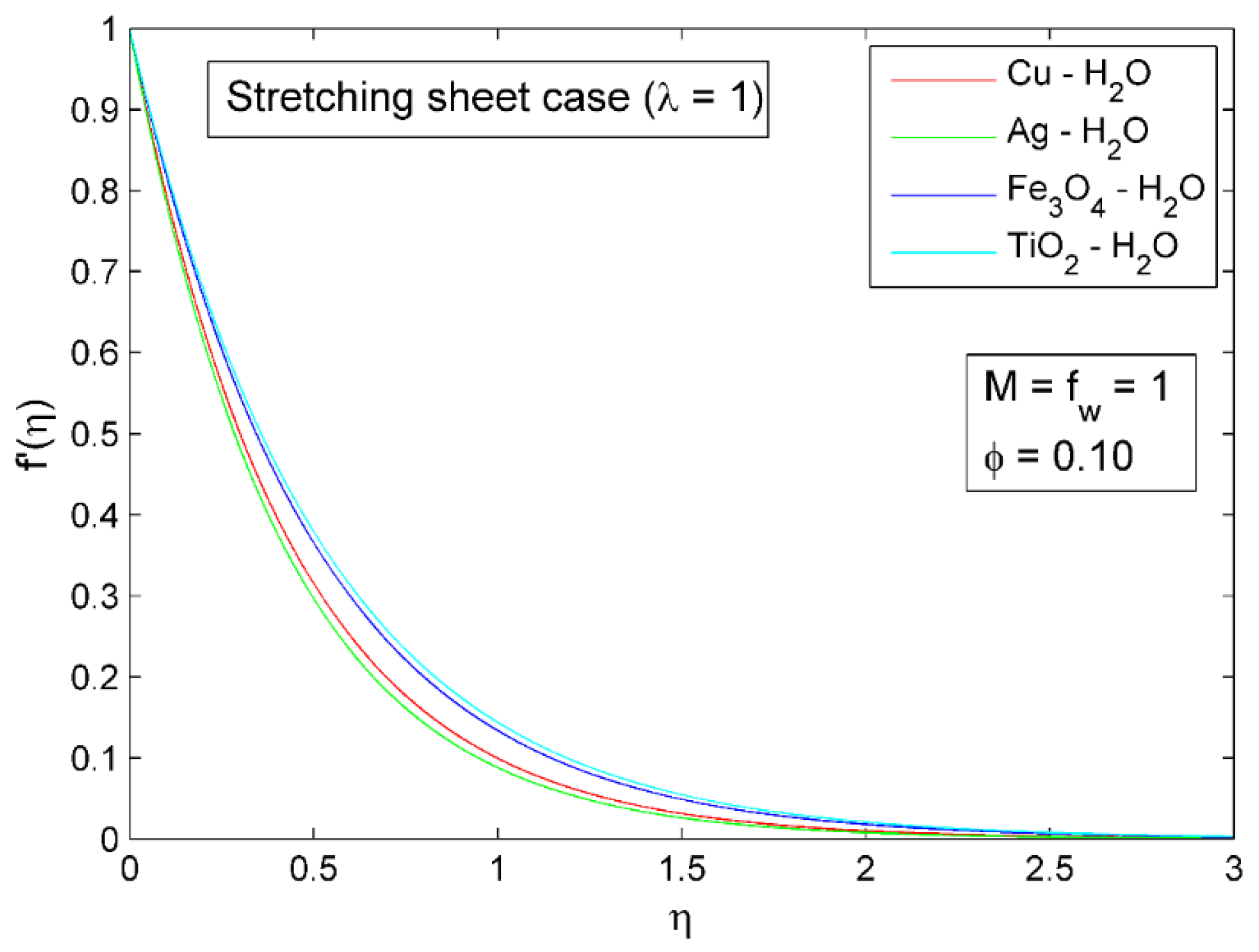

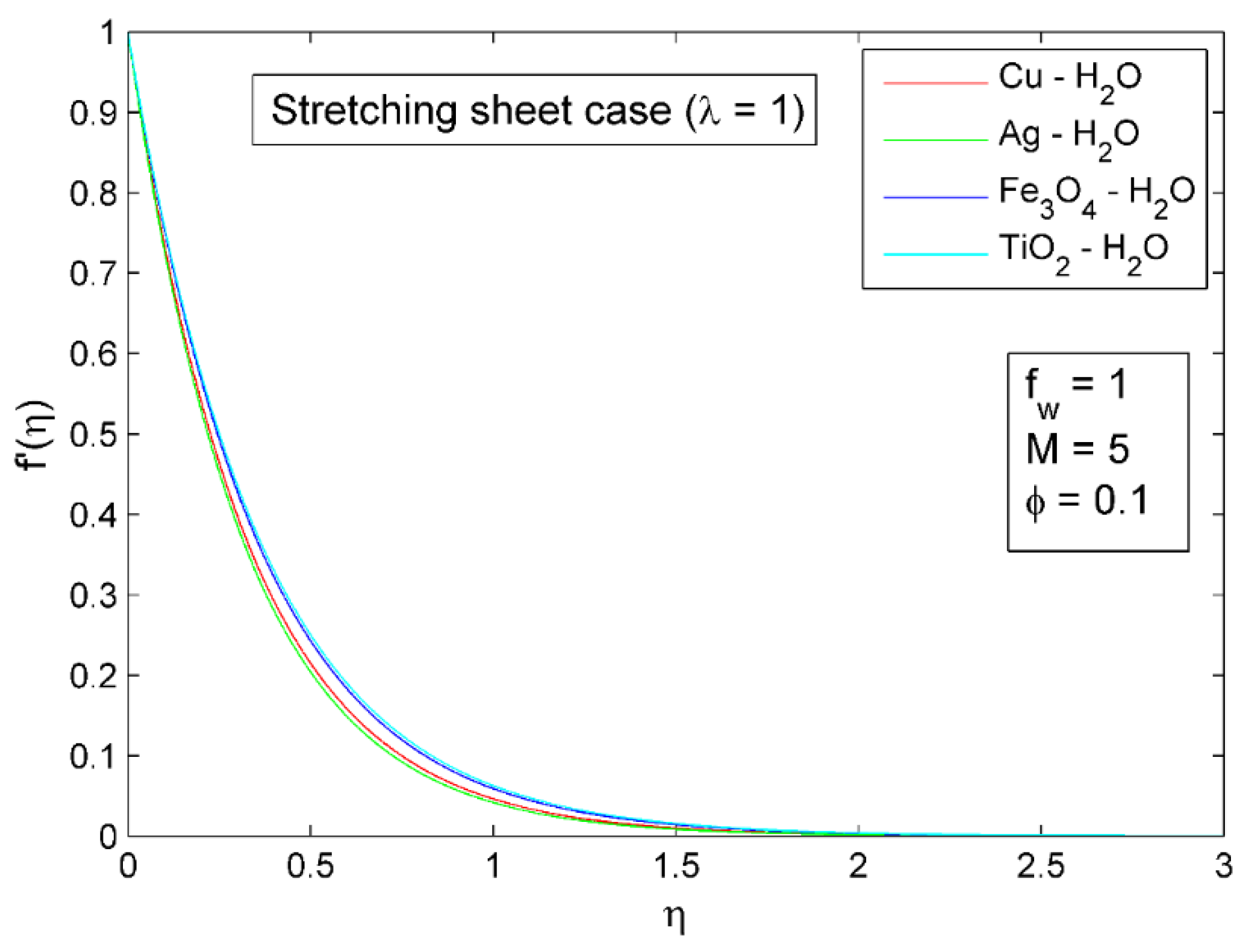
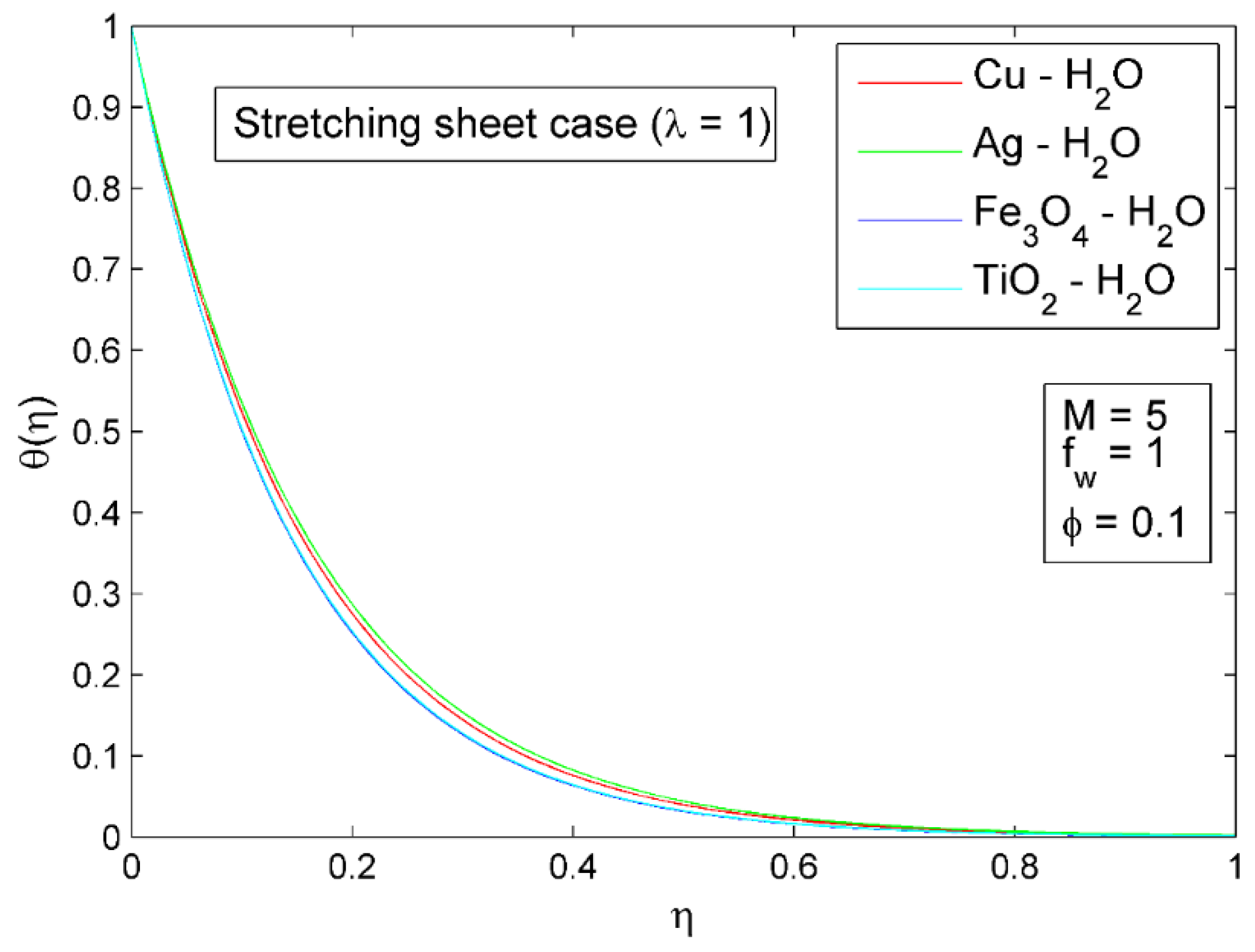
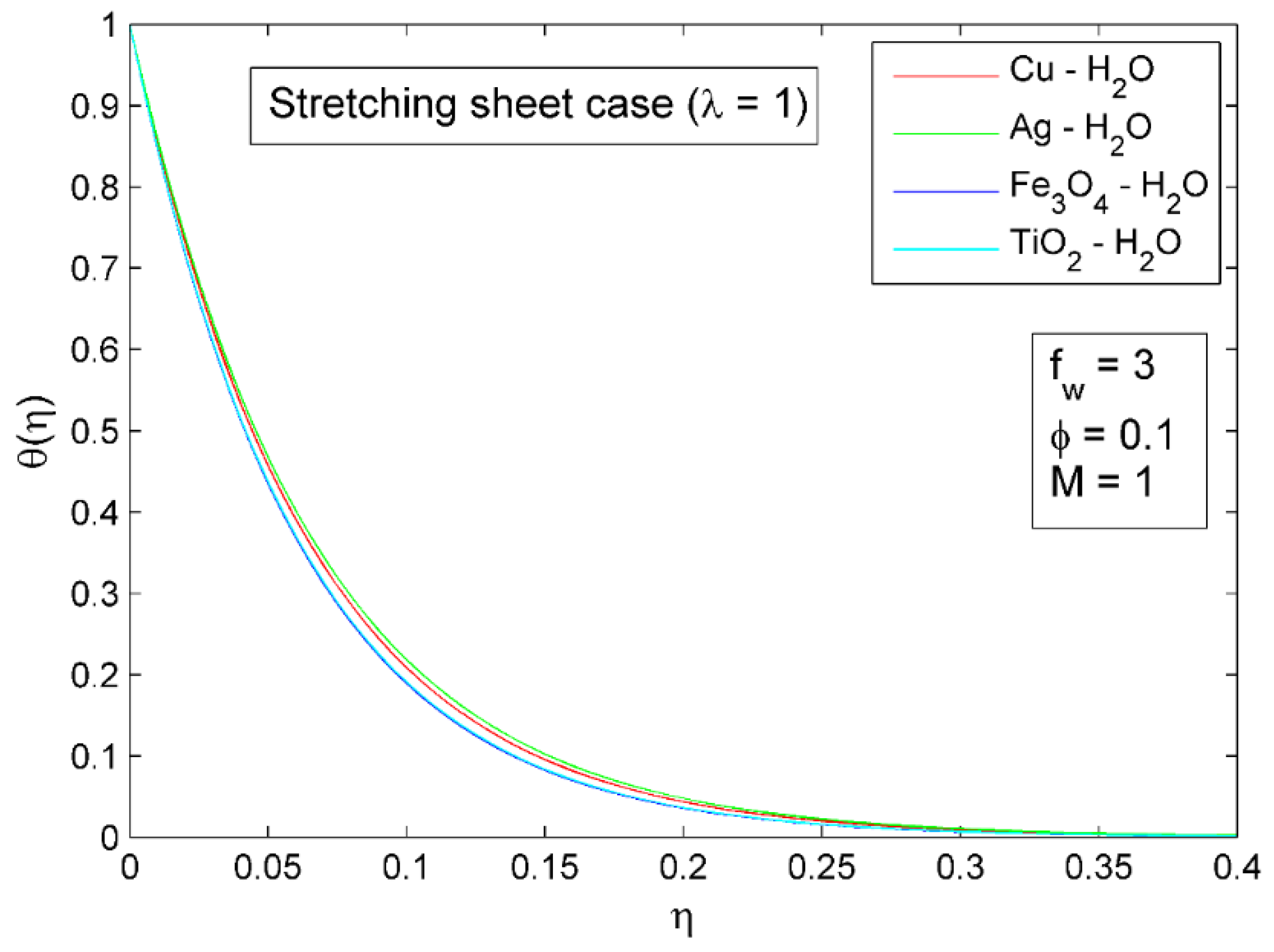
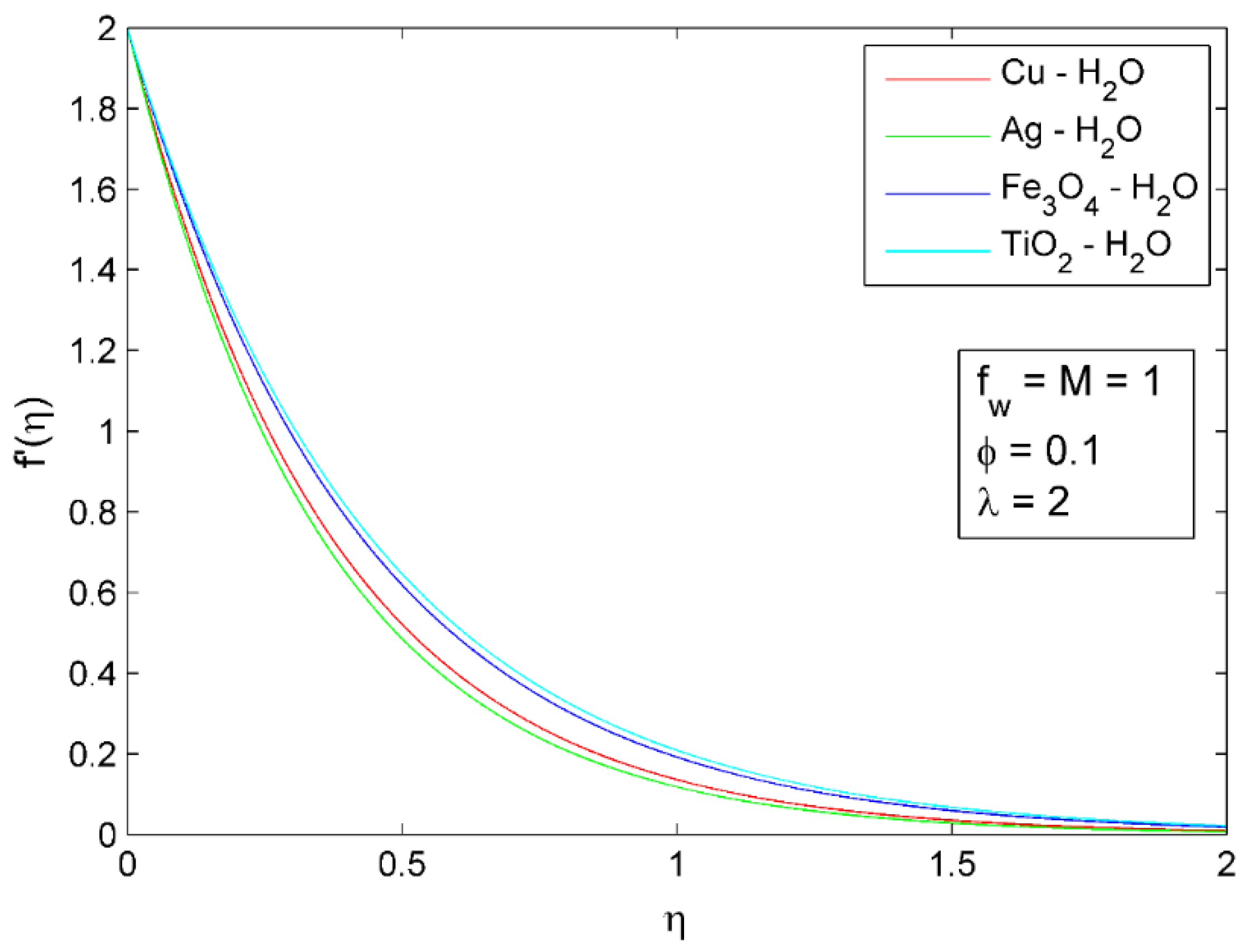
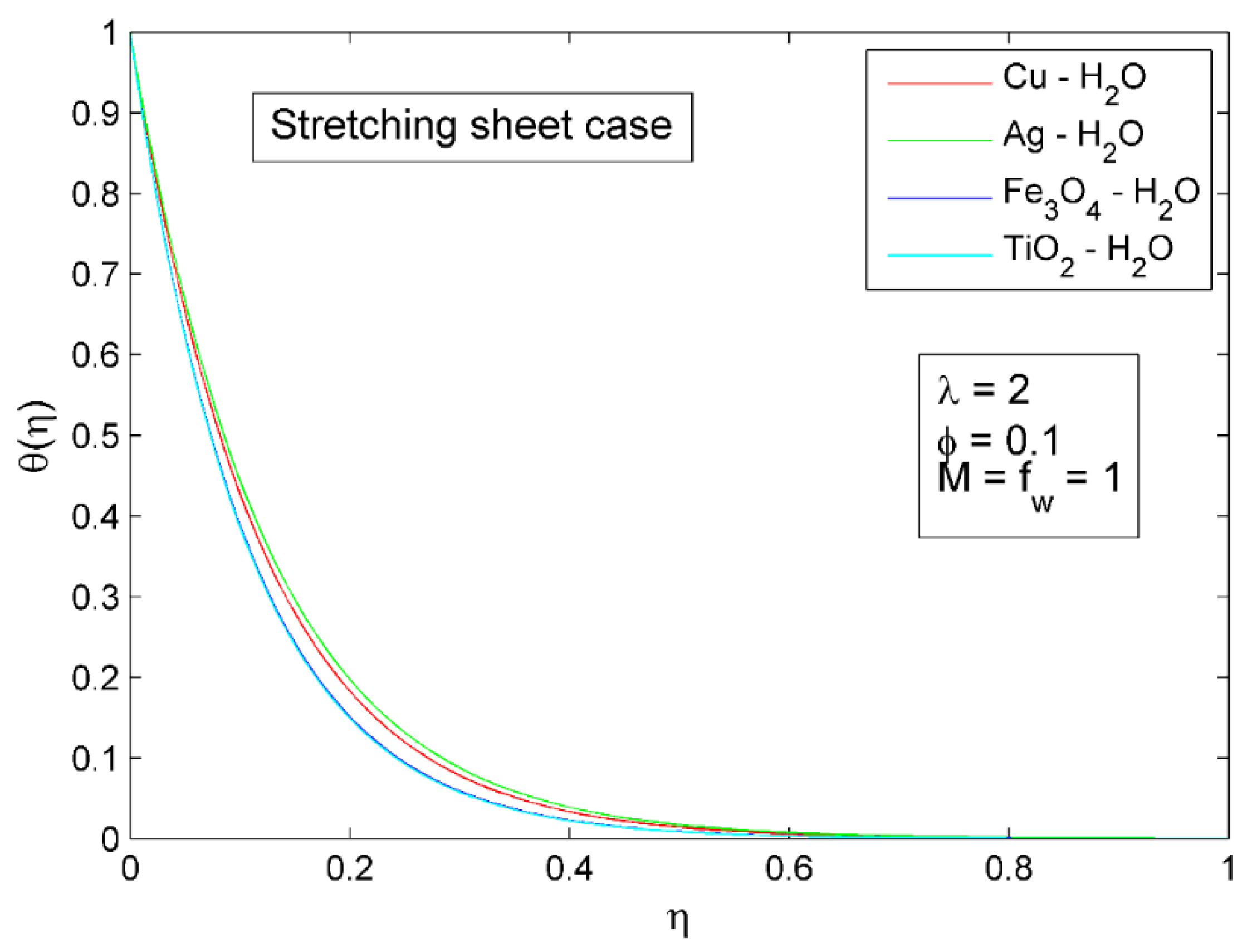
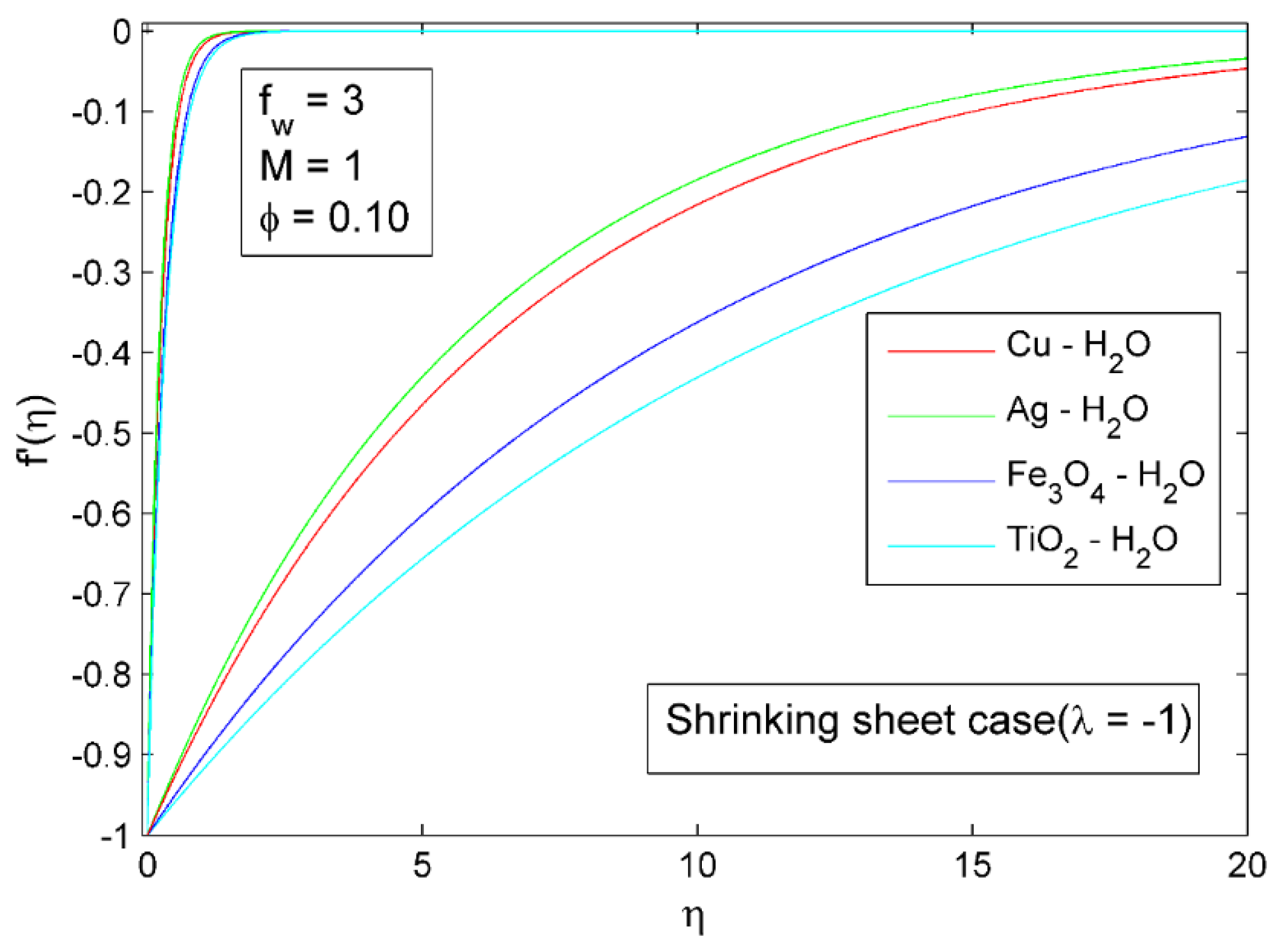
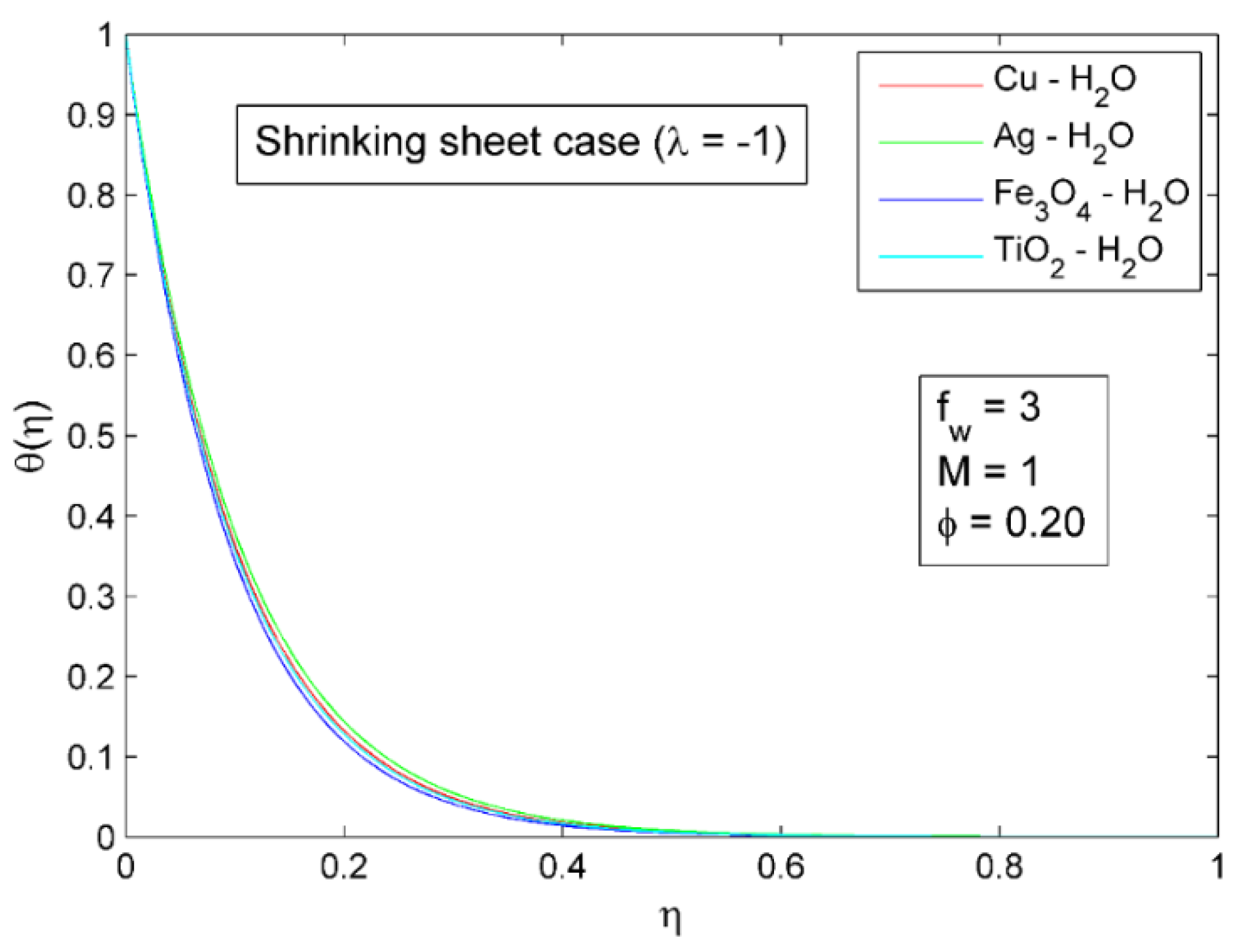

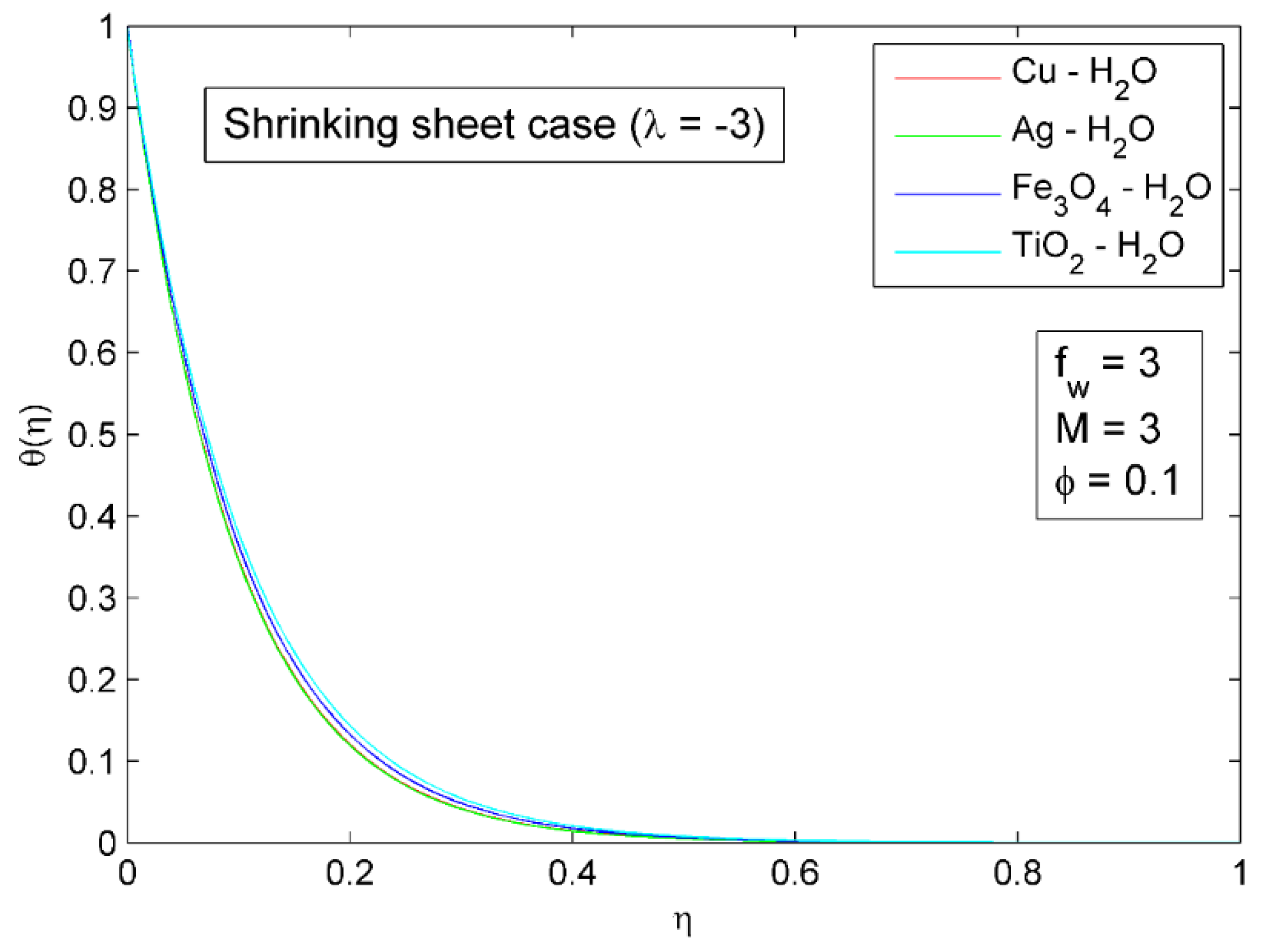
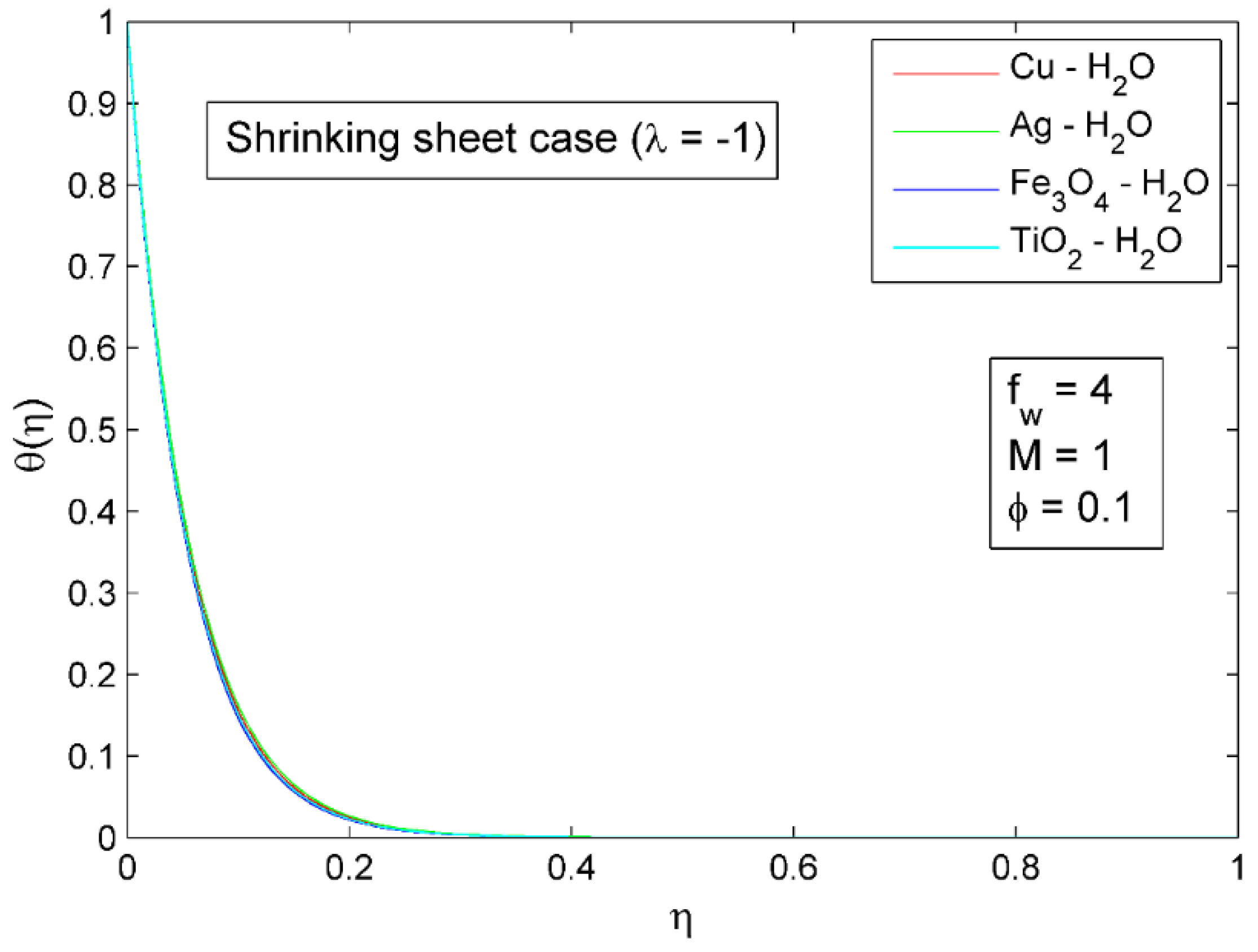

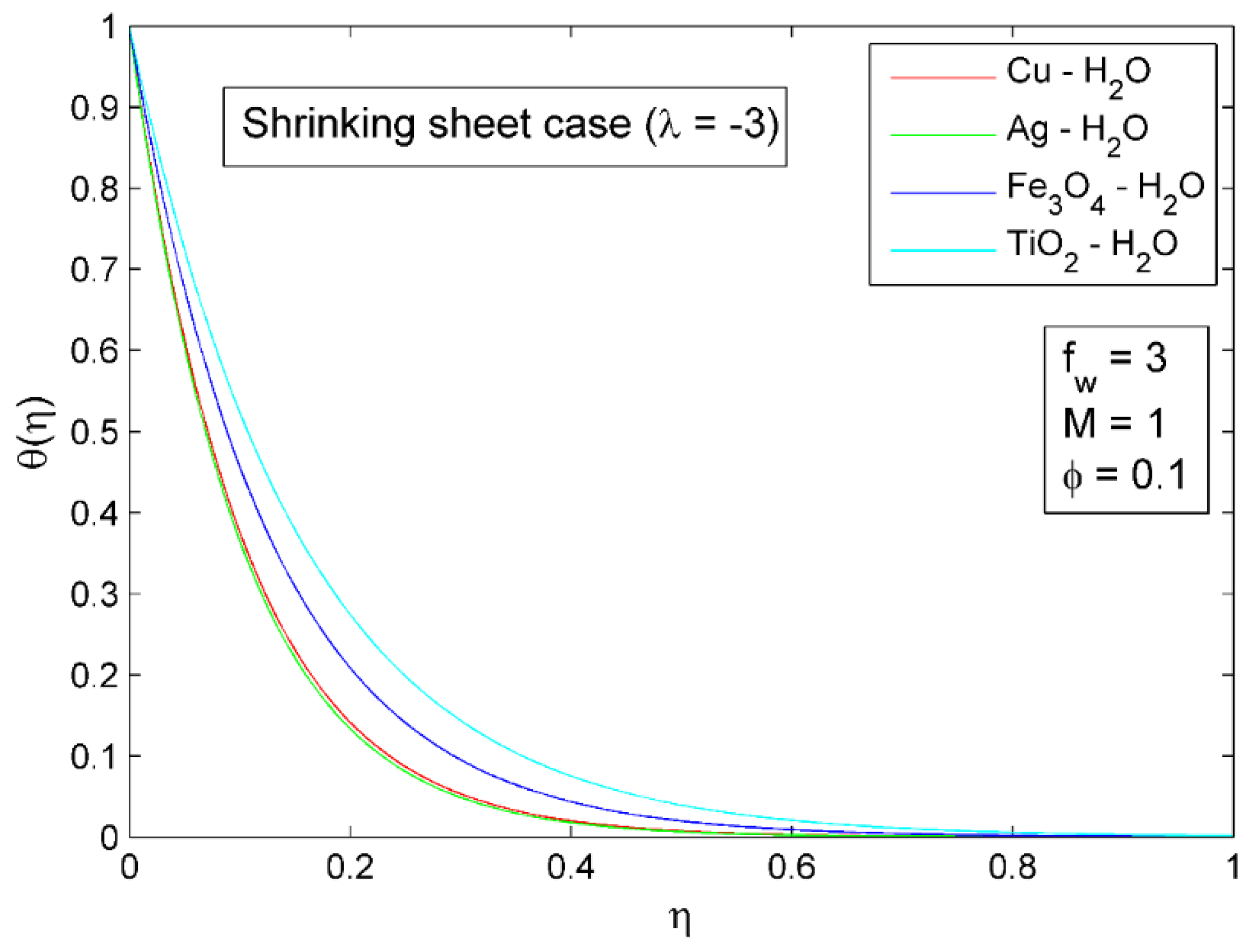
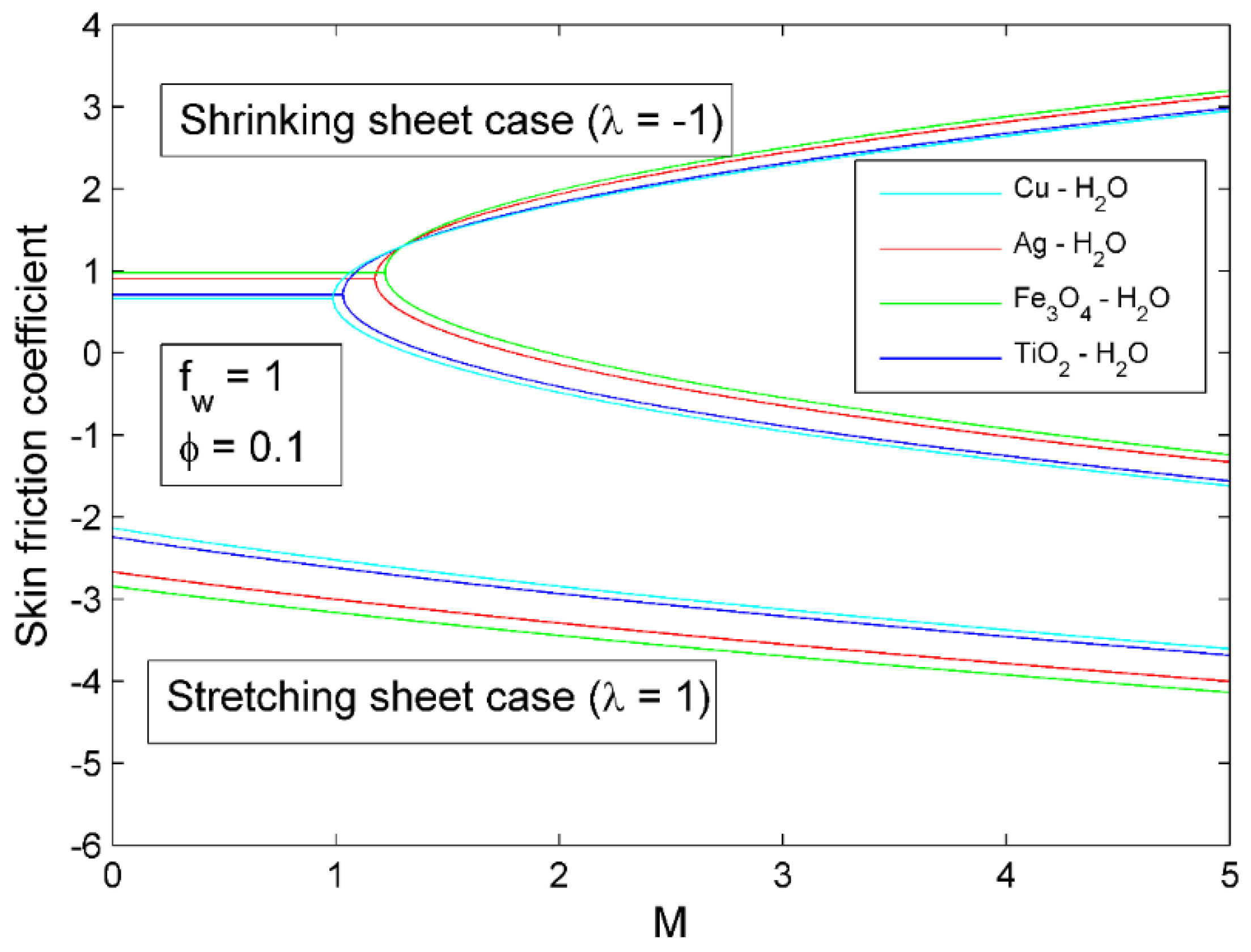
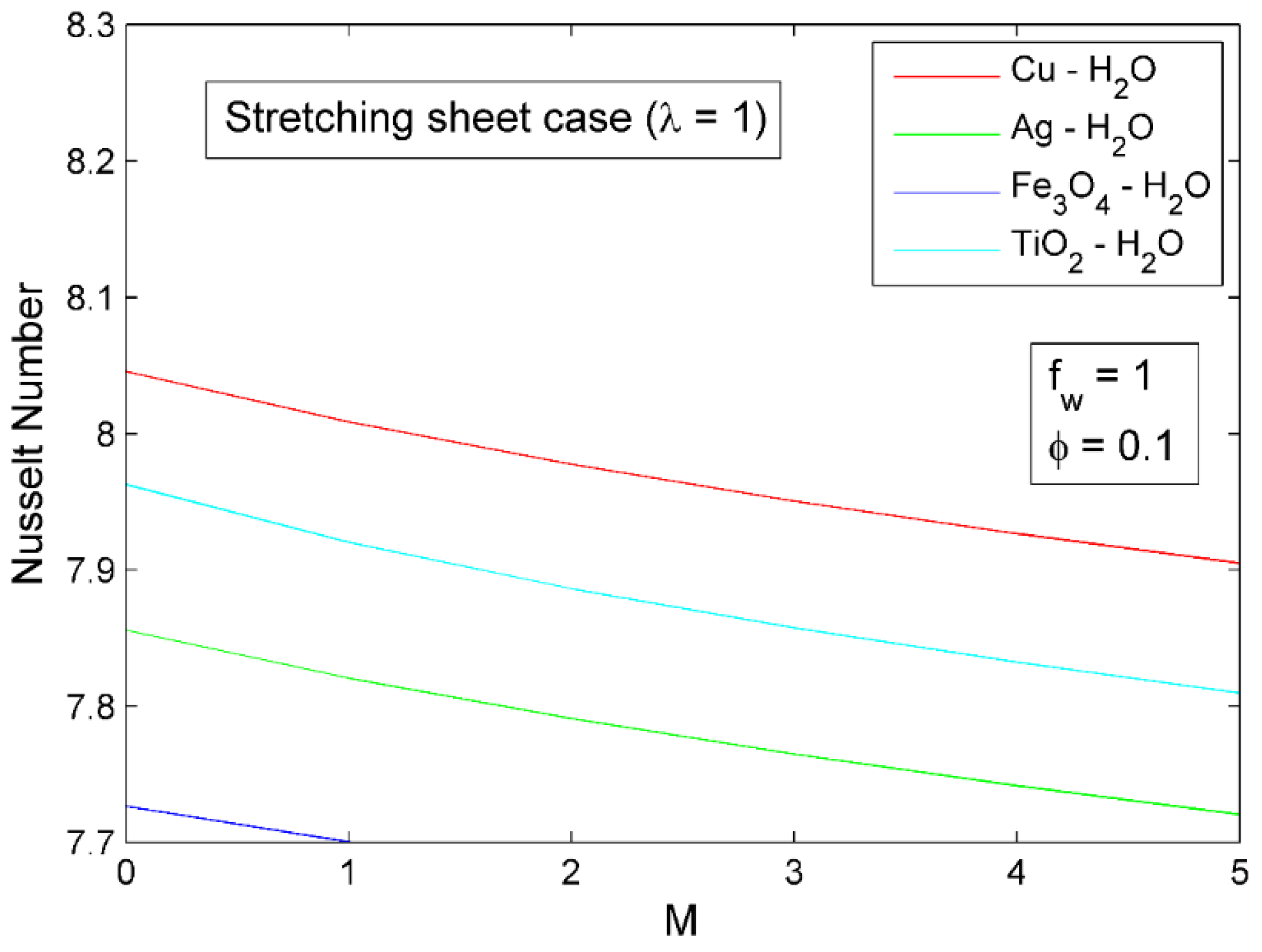
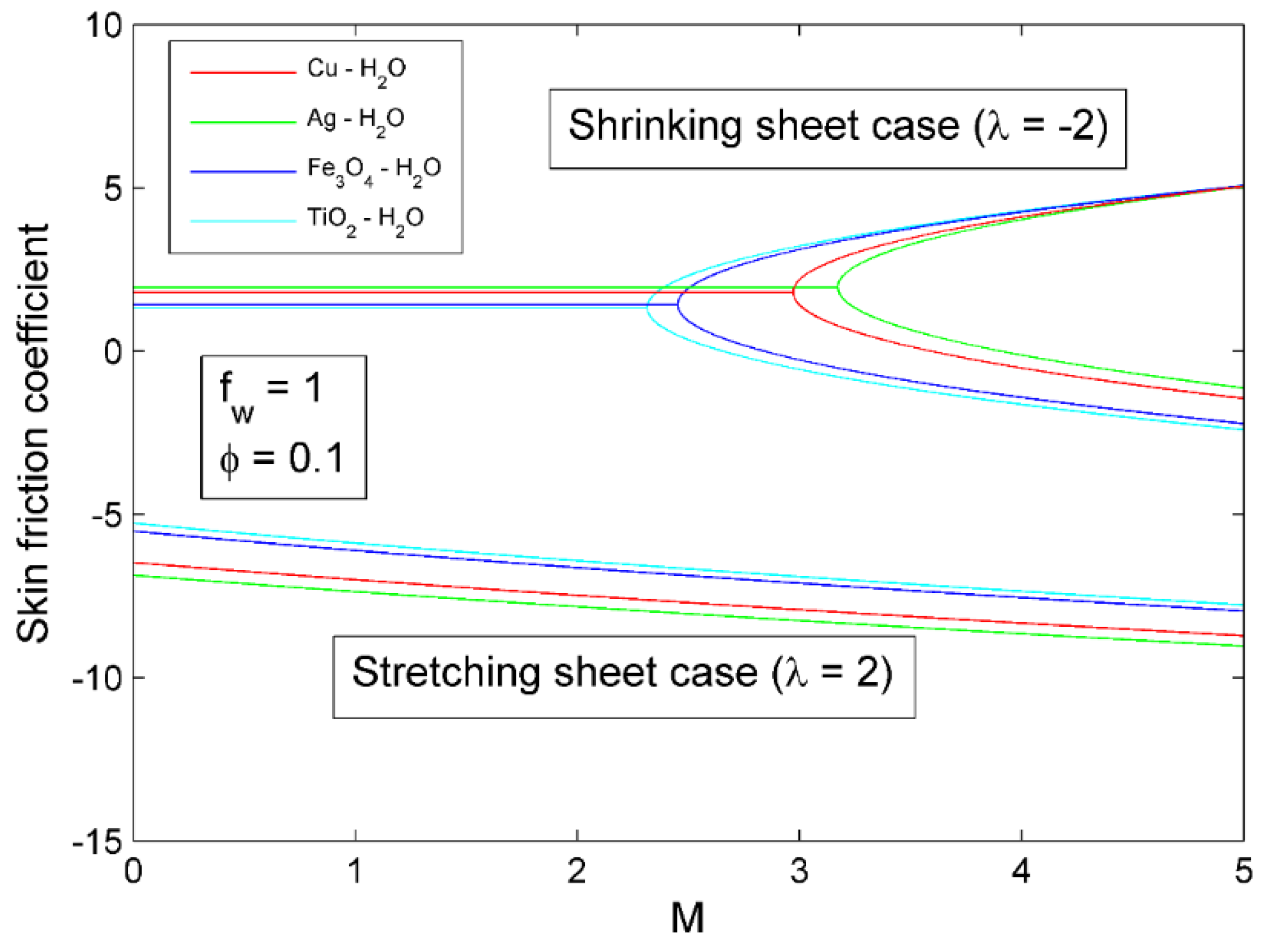
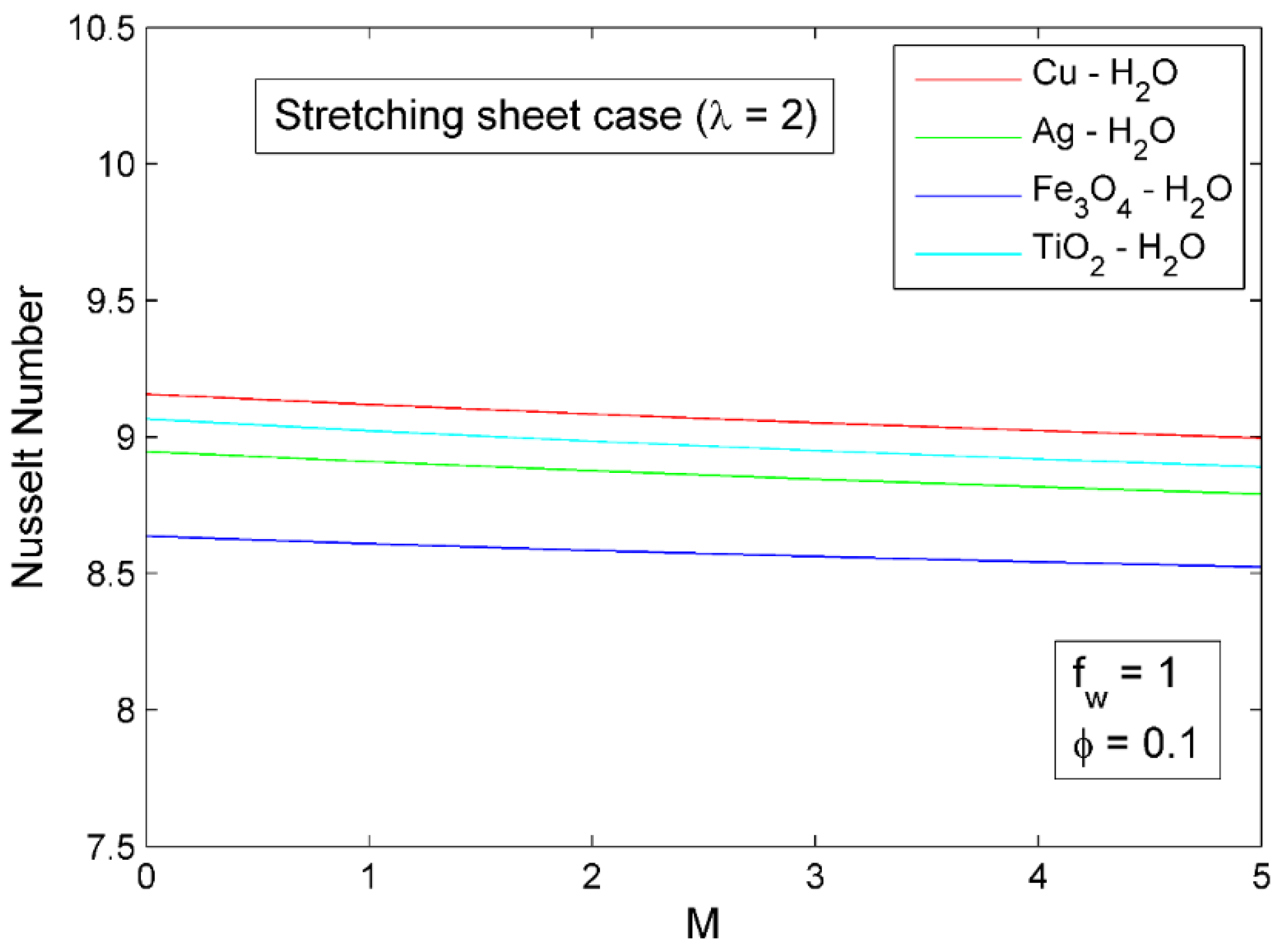
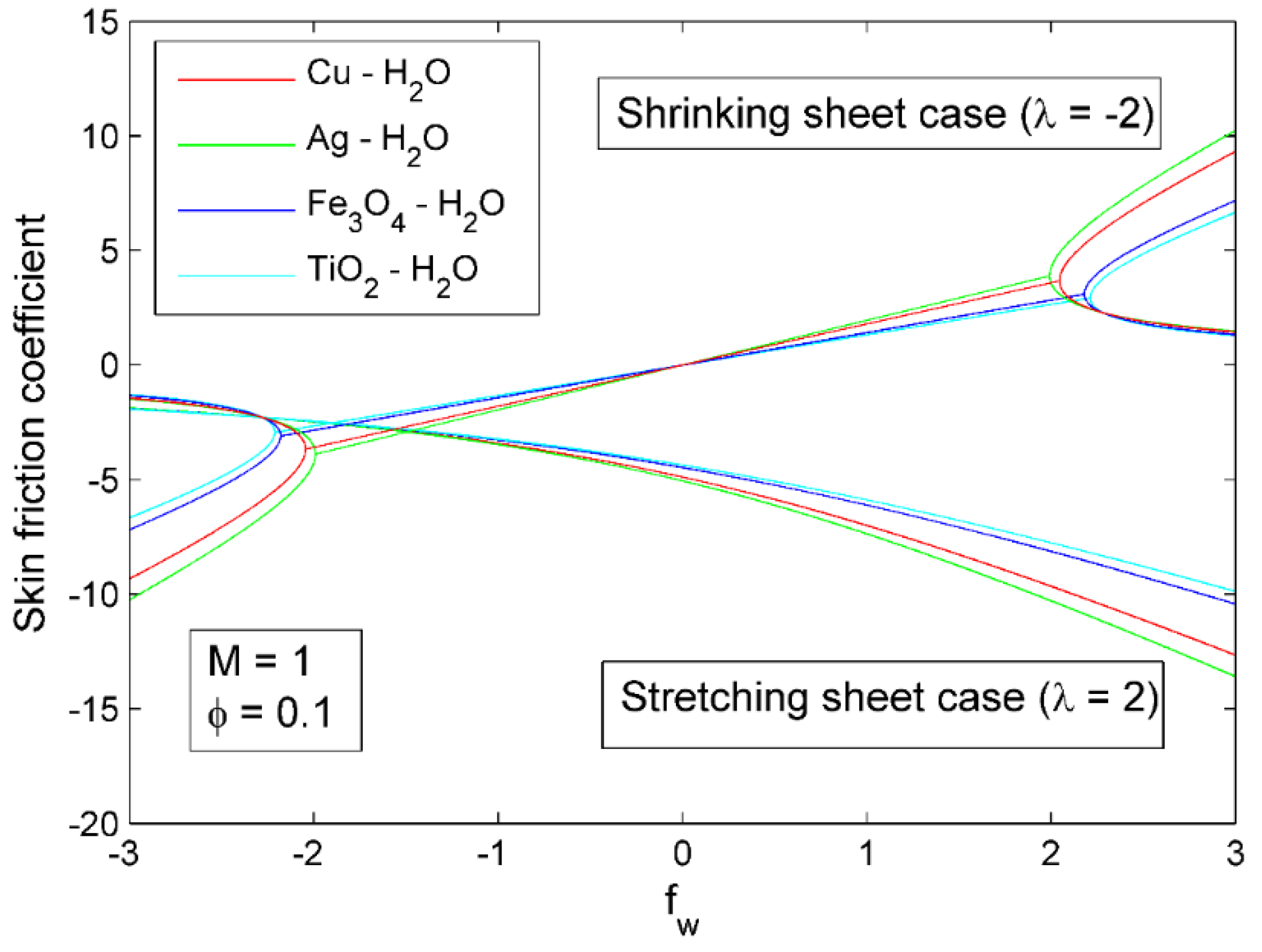

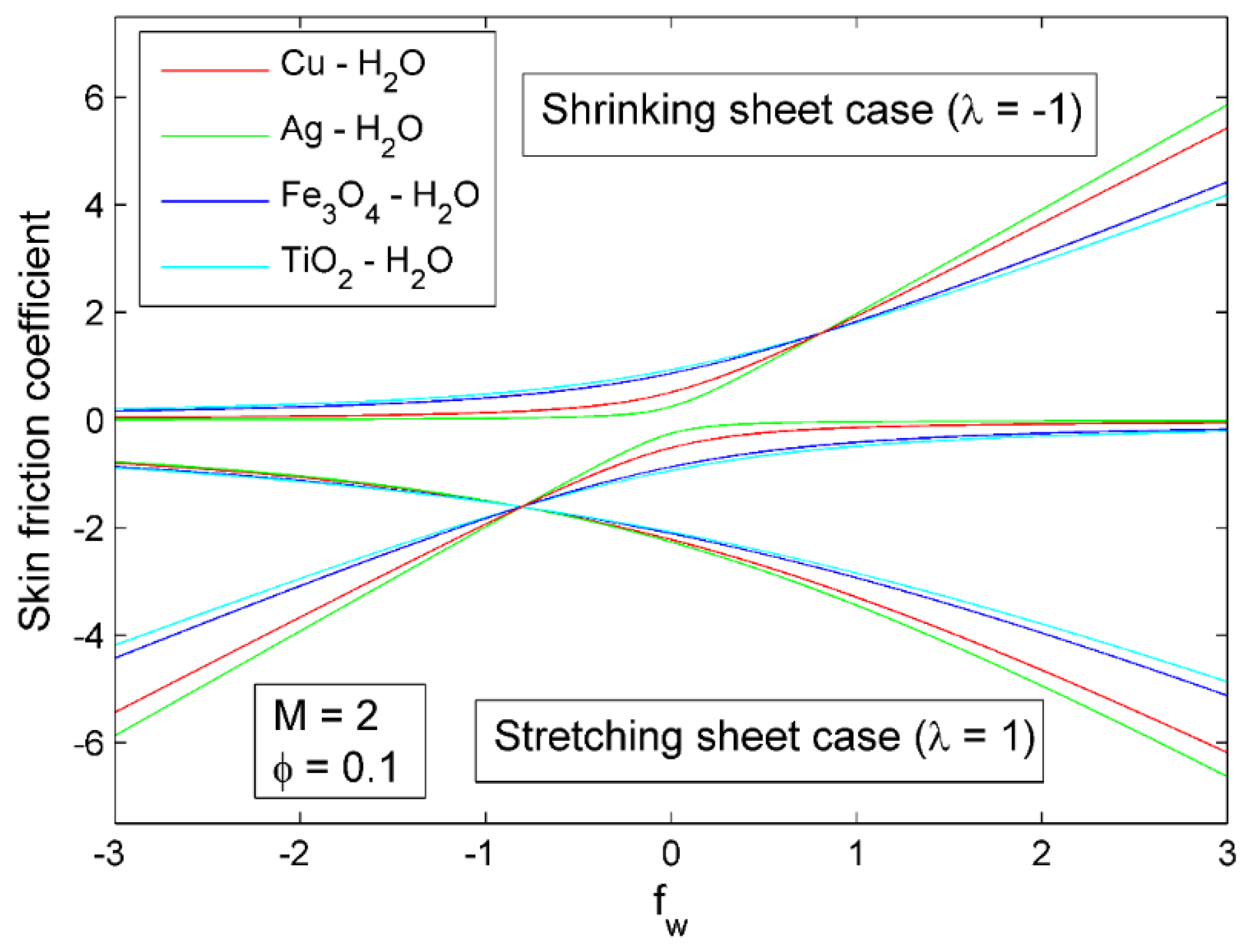
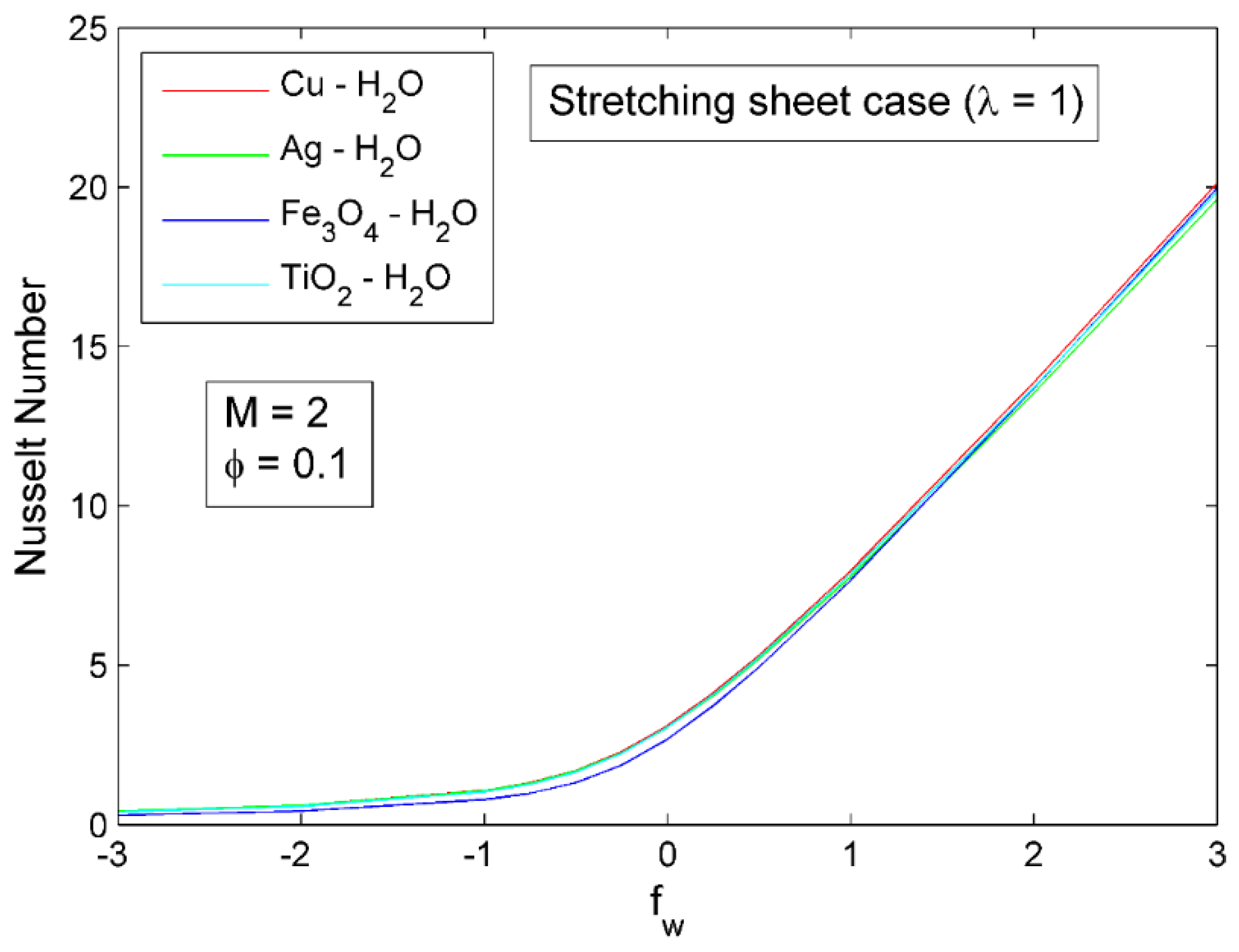
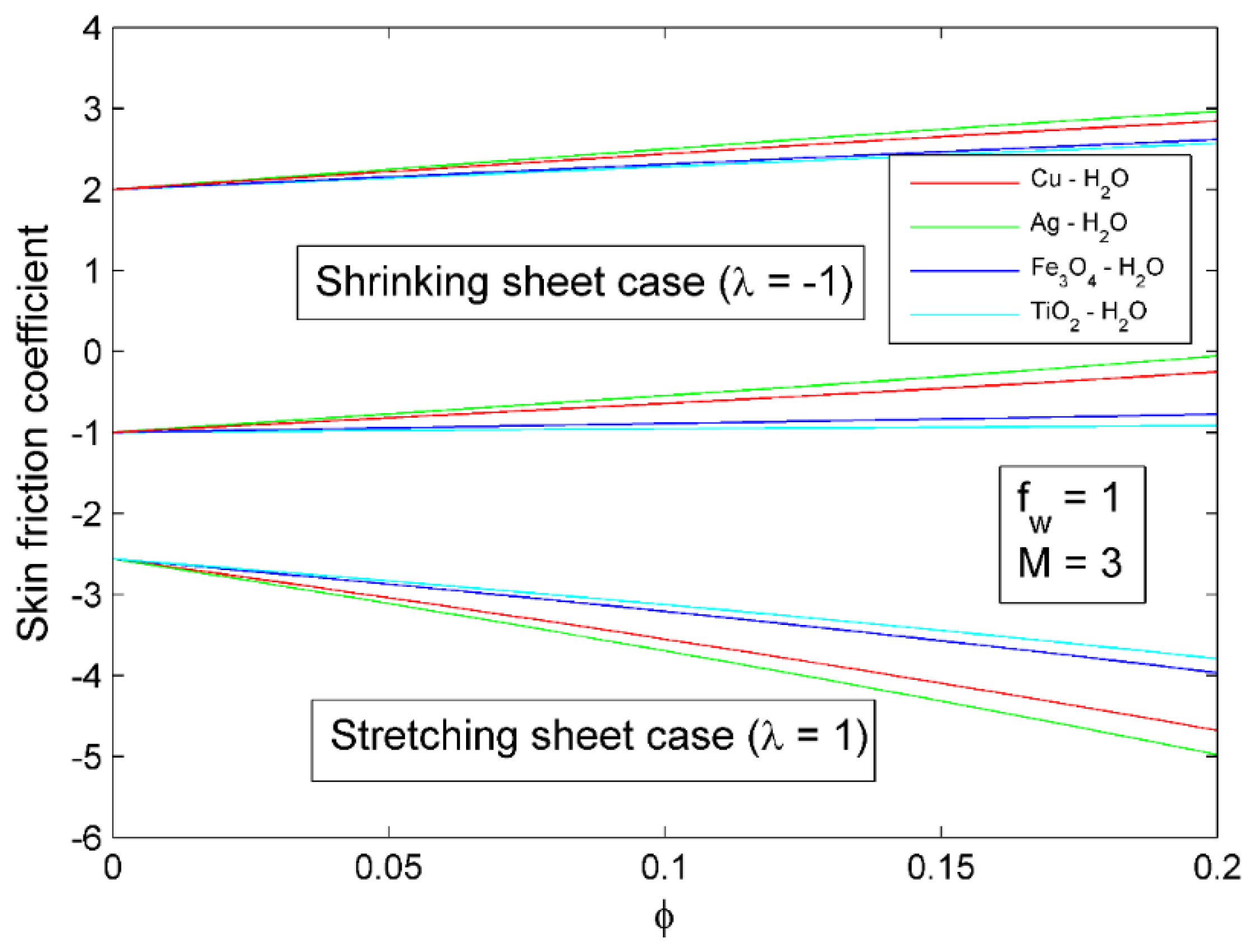

| Thermal Properties | Base Fluid (Water) | ||||
|---|---|---|---|---|---|
| 4076.4 | 385 | 235 | 670 | 686.2 | |
| 997.8 | 8933 | 10,500 | 5180 | 4250 | |
| 0.60475 | 401 | 429 | 9.7 | 8.9538 |
| M | Current Result | Turkyilmazoglu [43] | Freidoonimehr [35] |
|---|---|---|---|
| 0 | 2.414214 | 2.41421356 | 2.39871456 |
| 2 | 3.000000 | 3.00000000 | 2.98555535 |
| 5 | 3.645751 | 3.64575131 | 3.61168892 |
| −2 | −1.23606798 | −0.98434789 | −0.84071464 |
| −1 | −1.56155281 | −1.34999009 | −1.19502776 |
| 0 | −2 | −1.91959518 | −1.78891346 |
| 1 | −2.56155281 | −2.72953534 | −2.67793892 |
| 2 | −3.23606798 | −3.74343838 | −3.80653696 |
| −2 | 0.73205081 [−2.73205081] | 0.30238824 [−3.06147873] | 0.07702940 [−3.04285172] |
| −1 | 1 [−2] | 0.49409453 [−1.87363978] | 0.14406428 [−1.62697544] |
| 0 | 1.41421356 [−1.41421356] | 0.96216172 [−0.96216172] | 0.48413742 [−0.48413742] |
| 1 | 2 [−1] | 1.87363978 [−0.49409453] | 1.62697544 [−0.14406428] |
| 2 | 2.73205081 [−0.73205081] | 3.06147873 [−0.30238824] | 3.04285172 [−0.07702940] |
| Pr | Current Value | Abolbashari [44] | Freidoonimehr [35] |
|---|---|---|---|
| 0.72 | 0.80863135 | 0.80863135 | 0.80863135 |
| 1.00 | 1.00000000 | 1.00000000 | 1.00000000 |
| 3.00 | 1.92368259 | 1.92368259 | 1.92368259 |
| 7.00 | 3.07225021 | 3.07225021 | 3.07225021 |
| 10.00 | 3.72067390 | 3.72067390 | 3.72067390 |
Publisher’s Note: MDPI stays neutral with regard to jurisdictional claims in published maps and institutional affiliations. |
© 2022 by the authors. Licensee MDPI, Basel, Switzerland. This article is an open access article distributed under the terms and conditions of the Creative Commons Attribution (CC BY) license (https://creativecommons.org/licenses/by/4.0/).
Share and Cite
Shang, P.; Ali, A.; Ali, H.; Amjad, M.; Ishaq, M.; Aslam, M.S. A Comparative Study of Thermal Performance of Different Nanofluids: An Analytic Approach. Symmetry 2022, 14, 2439. https://doi.org/10.3390/sym14112439
Shang P, Ali A, Ali H, Amjad M, Ishaq M, Aslam MS. A Comparative Study of Thermal Performance of Different Nanofluids: An Analytic Approach. Symmetry. 2022; 14(11):2439. https://doi.org/10.3390/sym14112439
Chicago/Turabian StyleShang, Peipei, Amjad Ali, Haider Ali, Muhammad Amjad, Muhammad Ishaq, and Muhammad Saqlain Aslam. 2022. "A Comparative Study of Thermal Performance of Different Nanofluids: An Analytic Approach" Symmetry 14, no. 11: 2439. https://doi.org/10.3390/sym14112439
APA StyleShang, P., Ali, A., Ali, H., Amjad, M., Ishaq, M., & Aslam, M. S. (2022). A Comparative Study of Thermal Performance of Different Nanofluids: An Analytic Approach. Symmetry, 14(11), 2439. https://doi.org/10.3390/sym14112439








